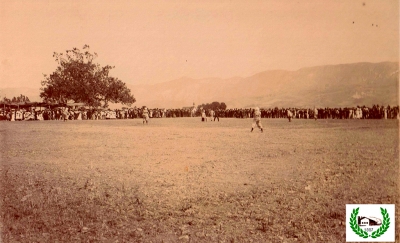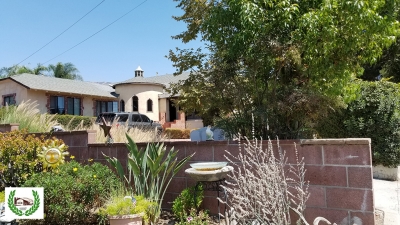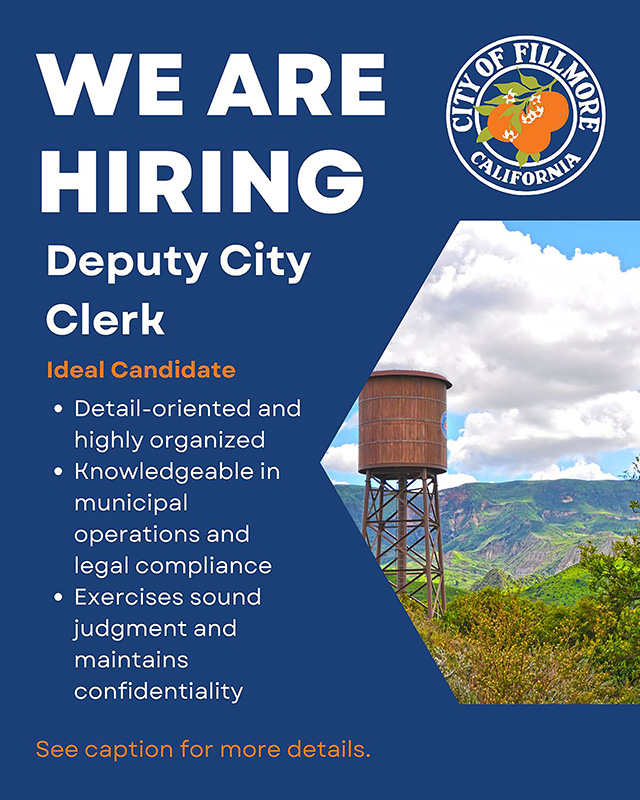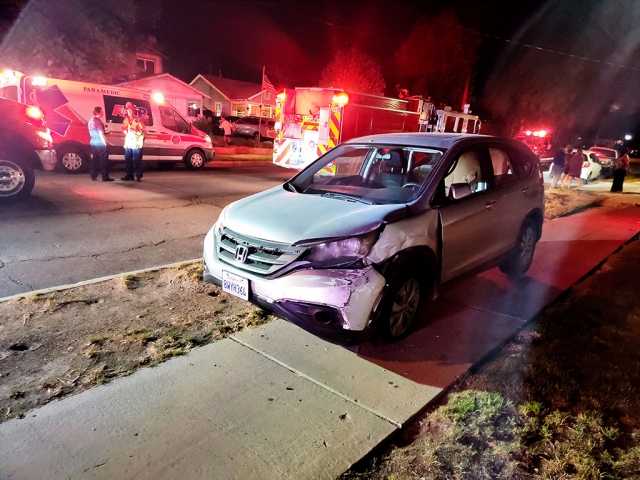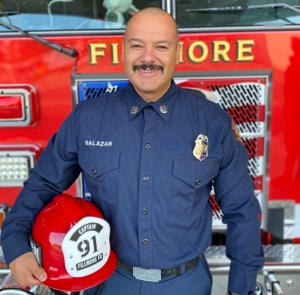|
By Gazette Staff Writers — Wednesday, September 1st, 2021
Written by Mary Nunez My grandfather came to Fillmore in 1962, driving up in an old station wagon with his wife and his then six kids. He was moving away from his family down in Orange County, but as it turned out, he was leaving them only to find a new one. A quirky, hard-working, wonderful community, filled with beautiful old souls. A rich valley ribbed with citrus groves and the lingering remnants of stone fruit orchards. A place with a sense of home. That was the Fillmore he found, the town he entrusted with educating his children, with his ranch, and with his future. I was born into that future in 2004. The daughter of a social butterfly, I was thrust into everything. I have entered every Fillmore Flower Show since I was 7(and attended the garden tour after), and in the Christmas parade, I was always one of the bedsheet - robed shepherds leading a goat down Central Avenue. None of this really matters, except to point out that those things haven't really happened this past year and a half. And yes, it's to keep us all safe, and of course that's important. But for the past few months, I've been considering how important my community is to me also. How much I can feel those events not being there, marked on the calendar. I loved those occasions; the runs, parades, holidays. All of it. But I realized something this past month, while in the middle of Faulkner's The Hamlet. A community is not made up of the events it organizes, its parades, or composed of only the floats who show up. A community is based on people. People who come together, creating connections and joy. Talking, laughing, and making memories together, taking pride in our town. There is history and guidance in those conversations. Stories about Rancho Sespe, and Camulos, and the way it was. Tidbits on everything from raising plants to raising children. Funny stories, tearjerkers: relationships. But they can’t take place unless we are willing to make a commitment to our community, and recognize that the future of this place, everything that makes it special lies in our hands. It would be too easy, as Covid, and it's Delta variant rage, to give in to fear, not to hope for the next conversation, the next time we can all be together as a community. To lose the tight-knit sense of family culled and protected over generations. Instead, as the library opens, and school comes back into session, I hope we come back stronger than ever, like chaparral after a fire. At my grandfather’s funeral, the church and hall were filled, with still more people spilling into the outside. Half of those people came from this town, and that is just as much a testament to them as it is to him. My only goal in this “letter” is to try and ensure that the respect, generosity, and friendship I have grown to love here does not get lost in these isolated days. A friend of mine from Santa Paula likes to make fun of Fillmore - he knows it irks me. But I am proud that our town is small - that you can run into someone just by walking downtown. I am proud of the heritage of the grower., the pickers, and our Mayberry-ness. The ‘F’ on the mountain lighting up at night, and the way San Cayetano stands over us. I hope you’re proud too. |
|
By Gazette Staff Writers — Wednesday, September 1st, 2021
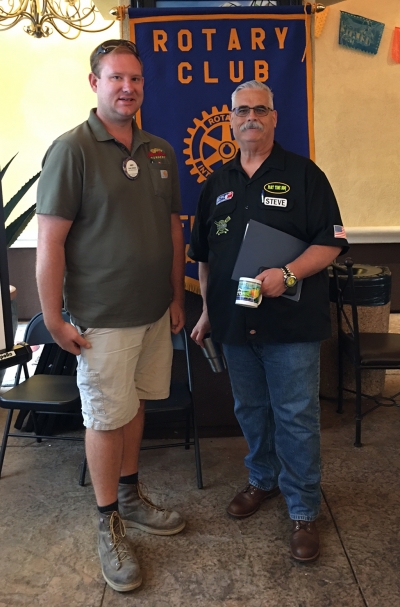 Pictured are Rotary President Andy Klittich and speaker Steve Conway of Fillmore who qualified for the World Finals to held in Arizona and spoke with the club about his upcoming benefit for the Boys & Girls Club of SCV. Photo courtesy Rotary Club Member Martha Richardson. Enlarge Photo  Pictured above is FUSD Superintendent Chrissy Schieferle, with Rotary Club President Andy Klittich, after her speech to the group. Enlarge Photo Steve is a Fillmore native and a competitor in the sport of BBQ. He has been competing for several years and is a member of the State Steak Cookout Association. In 2020 he won a Golden Ticket which was followed by the World Finals in Texas where he placed 36th in the world! In 2021 he had competed in 21 events in five states and won another Golden Ticket which qualified him for the World Finals in Arizona. His passion for BBQ has led him to host a World Class BBQ here in Fillmore, Central Steak Out, on October 30th. The event will benefit the Boys & Girls Club of the Santa Clara Valley. This event will include a Kids BBQ; each kid will receive a New York steak to BBQ and a grill. To find out more about this event go to www.centralsteakout.com. Fillmore's new Superintendent Chrissy Schieferle grew up in Fillmore and graduated from FHS. She began as a |
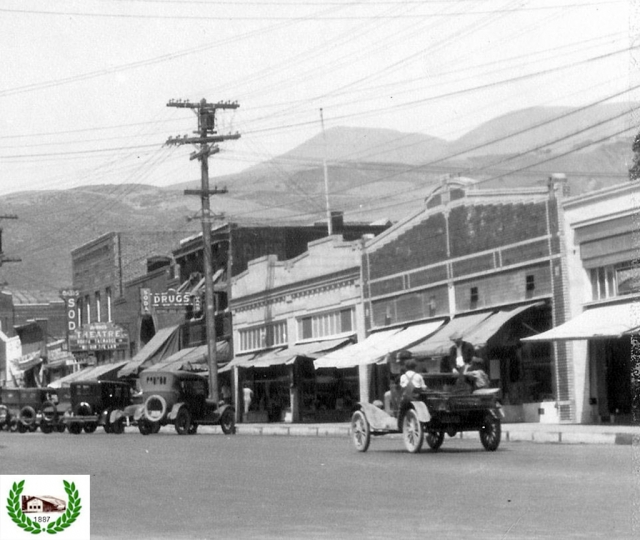 322-330 Central Avenue as it appeared in 1920 (built in 1910) as a single building with two storefronts. Photos Courtesy Fillmore Historical Museum. Enlarge Photo By Gazette Staff Writers — Wednesday, September 1st, 2021
Courtesy Fillmore Historical Museum Often we seem to highlight places that are fairly well known in our community. But there are some locations which are seen almost every day that most of us don’t pay much attention to. Our first location is on Kensington Drive. Close to the west end of the street, there is a cluster of 3 sycamore trees, raising the sidewalk and towering over their surroundings. Long before the arrival of the railroad in 1887, this was a location of a corral for sheep shearing. Raising sheep here had been a long established business before development would occur in the late 19th century. But why was it there? The “why” is because Pole Creek, then known as “yellow Creek” ran right past it. The water in the creek was needed by the sheep shearers and the animals. The creek also encouraged the growth of the sycamore trees which still remain along its original path. It wasn’t until the early 20th century that the creek’s path was changed to flow south as it does today. The original creek crossed what would become Fillmore from east to west roughly following part of 4th St and dropping down to about the corner of First and Saratoga, then proceeding past those Kensington Drive sycamore trees and on west to the Sespe River. The next notable unnoticed spot is the corner of First and Saratoga. There on the south east corner is a lonely concrete post with the date, 1936, near the top. That post was the support for Fillmore’s first neighborhood mail drop box, installed September 30, 1936. The first person to post a letter there was the mayor, Lester Price. Free mail delivery to local residences was just beginning. Before this date residents picked up their mail at the post office. Before mail delivery began that October, home owners needed to buy and install their own mailboxes. The new mail carriers were required to take a civil service exam and, as was customary at the time, women were not allowed to apply. There were two daily deliveries with the postal carriers leaving the post office at 9:15 a.m. and at 12:45 pm. The carriers did not wear uniforms and did not carry stamps, but they could pick up mail from the boxes to take to the post office. One of the first two carriers, “Brick” Fansler reported that every dog on his route knew he was coming and set off barking and charging because of the sound made by his corduroy slacks as he walked the route. This was probably the beginning of a love hate relationship between mail carriers and local dogs. Located on the northwest corner of First St. and Saratoga St. is the home once owned by John McNab, manager of Sespe Land and Water Co. and member of the family which laid out the City of Fillmore. The house is thought to have been originally located on Catalina Island and moved to Fillmore in 1910. The site was popular for picnicking in the early days because of the large sycamore trees there. Baseball was also a popular pastime then. Fortunately, someone had the foresight to take a picture of a game held in about 1910 as you will see in one of the accompanying photos. The last locations mentioned in this article are in downtown Fillmore on the east side of the street at 328-330 and 322-324 Central Ave. The building at 328-330 was built in 1910 as a single building with two storefronts. Today it appears as two separate buildings as it has been completely remodeled over the years. In 1915 a new building was built just to the south, adjoining this building at 332-324 Central Ave. The buildings’ look was nearly identical at the time with just a few changes to the façade. This building looks today much as it did when built. Fillmore is fortunate to have retained as many of the original buildings as it has despite modernization, fires and earthquakes. This is a testament to the concern our citizens have for their shared history. |
Now Hiring: Deputy City Clerk
The City of Fillmore is seeking a detail-oriented and highly organized professional to join our City Clerk’s Office as Deputy City Clerk. This key role supports City Council operations, maintains official records, ensures legal compliance, and helps uphold transparency in local government. If you’re passionate about public service, governance, and supporting elected officials, we encourage you to apply. Learn more and apply at www.fillmoreca.gov.
|
By Gazette Staff Writers — Wednesday, August 25th, 2021
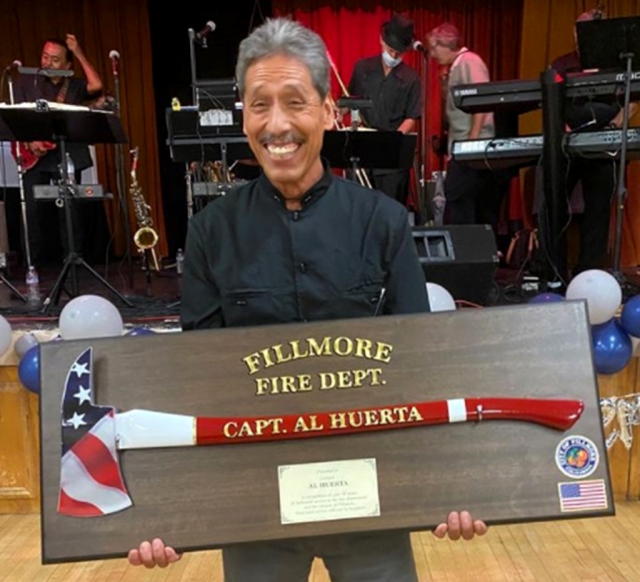 Congratulations Captain Al Huerta on your retirement! In recognition of your 38 years of service and dedication to the Fillmore Fire Department and the citizens of Fillmore, your loyal service will not be forgotten! “We make a living by what we get, but we make a life by what we give.” — Winston Churchill. Thank you for giving, Al! Enlarge Photo |
|
By Cindy Blatt — Wednesday, August 25th, 2021
I would like to point out some incorrect information that was stated in the City of Fillmore’s press release re: pool project halt, published in the Fillmore Gazette on August 18. In the second paragraph, it states that FUSD has exclusive use of the pool 8 months of the year. That is an incorrect statement. That has not been the case in the past and If you read the original proposed agreement from 2021 and all subsequent proposed agreements you will find on page 1, under Recitals, paragraph 3, first sentence: "Whereas, City is willing to grant to District a license for the non-exclusive use of the pool....". The agreement repeatedly refers to “non-exclusive use”. The City’s statement is misleading. During the 2021 FHS swim season during the District's non-exclusive use of the pool, the City rented out the pool on several Saturdays to Trinity Classical Academy from Valencia for high school swim meets. The press release makes it seem like the City does not have any right to pool use during the District's 8 months of use. Again, it is stated throughout the agreement that the District only has non-exclusive use of the facility Regarding the District requesting use of the pool during the City's exclusive use of the pool, before fall of 2018, the District's programs (swim team, water polo, cross-country, football, etc) used the pool during the summer months by agreement with City staff during down times or times when there were few City programs using the pool. The District programs did not conflict with any of the City's programs. The District programs worked around the City's programs. Over the past three years, access to the entire pool facility by FHS coaches and students has been whittled away in such a way to cause safety concerns and was a hindrance to providing quality and successful programs. Coaches were locked out of three rooms at the facility with no explanation. Coaches had had full access to the facility from March 2000 until Fall of 2018. Not until a complaint was issued by FUSD Athletic Trainer about no access to the AED in 2021 were coaches again given access to the First Aid Room and the AED. FHS equipment was removed from the pool site and the City claimed ownership. The press release states that the City was informed in July 2020 by the County of Ventura that the pool needed to be re-plastered. In fact the City was notified in July 2019 during an inspection of the pool of the need to re-plaster. I guess the City chose to ignore this and the County did not follow up until 2020. I have a copy of the Inspection report. It is public record. Re-plastering should not be a surprise. It should be something the City plans for. The pool is 12 years old. The Fillmore Aquatic Center is a City facility. The FUSD Board of Trustees agreed to fund 50% of the replastering work along with paying a monthly $4,500 rental fee. This was not good enough for the City. Now they threaten to close the pool. A pool closure will be a black eye for the City of Fillmore. The City complains that the City only uses the pool for three months of the year. The pool was built with the intention that the pool would have year-round programs. The City of Carpinteria, with a smaller population basis than Fillmore, seems to manage to have year-round programs at their Community pool, including working with their school district to include water polo and swim team programs. The main reason why the Aquatic Center has a fund balance deficit totaling over $800,000 is because the fund started in a deficit due to mismanaged capital spending and poor staffing management. The press release unfairly points a finger of blame at FUSD. |
|
By Gazette Staff Writers — Wednesday, August 25th, 2021
|
|
By Gazette Staff Writers — Wednesday, August 25th, 2021
Congratulations to recently promoted Fire Captain Paramedic Mike Salazar! Mike is assigned to A shift on Medic Engine 91. He has been with the department since 2012 where he started as a Firefighter/Paramedic. Mike joins the other captains with a wealth of knowledge, experience, and enthusiasm for the job! Congratulations Mike! |
|
By Gazette Staff Writers — Wednesday, August 25th, 2021
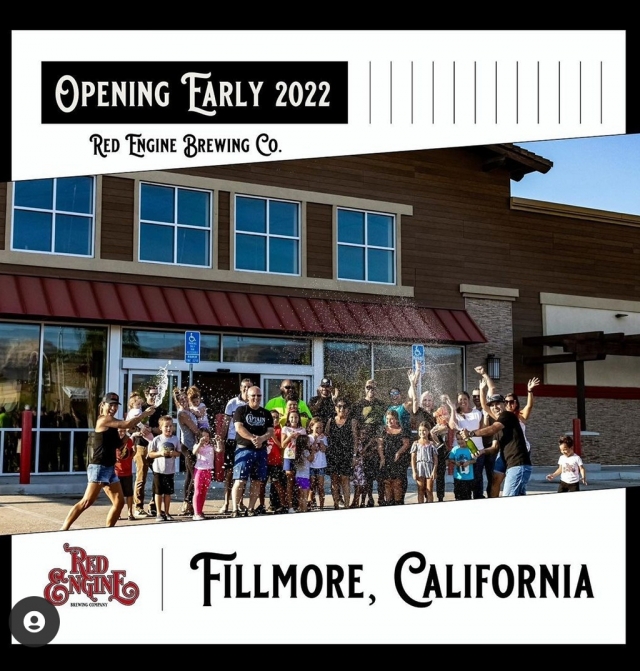 Red Engine Brewing Company will be opening in Fillmore, California in early 2022. Stay tuned for construction updates and sneak peeks as they transform their new building into our flagship location. Rumor has it it will be in the Family Dollar building on Ventura Street. Enlarge Photo |
|
By Gazette Staff Writers — Wednesday, August 25th, 2021
Ventura County Public Health has issued a new health order requiring all individuals, regardless of vaccination status, to wear face coverings when indoors in public settings, with limited exceptions. This order will take effect at 11:59 p.m. Friday, August 20, 2021. Businesses and other public entities have until 11:59 p.m. on Monday, August 23, 2021 to comply. The order will be in effect until 11:59 pm on September 19, 2021, or until it is extended, rescinded, superseded, or amended by the Health Officer. “As of today, we reached a rate of 28 cases per 100,000, a 40% increase. I hope that this order will increase mask usage in Ventura County. I expect that this will have a beneficial effect on the increase in COVID-19 infections we are seeing,” said Public Health Officer Doctor Robert Levin. As of August 20, the unadjusted case rate per 100,000 population over 1 day is 28, overall testing positivity over the past 7 days is 7.7% and the HPI lower quartile testing positivity rate over the past 7 days is 9.9%. Public Health reports 598 new COVID-19 cases and 3,995 new tests. There have been three additional deaths including a 98-, 76- and 87-year-old females. The order directs that face coverings must be worn over the mouth and nose – regardless of vaccination status – in all indoor public settings, venues, gatherings, and workplaces, including but not limited to offices, retail stores, restaurants and bars, theaters, family entertainment centers, conference and event centers, and government offices serving the public. Individuals, businesses, venue operators, hosts, and others responsible for the operation of indoor public settings must: • Require all patrons to wear face coverings for all indoor settings, regardless of their vaccination status; and This health order aims to reduce community transmission of COVID-19. Health officials are concerned by the substantial levels of increased community transmission, especially among unvaccinated people. In part, this is due to the widespread COVID-19 Delta variant, which is substantially more transmissible than previous forms of the virus. Recent information from the Centers for Disease Control and Prevention also indicates that even fully vaccinated individuals can in some cases spread the Delta variant to others, and so indoor use of face coverings provides an important added layer of protection. “Masking indoors must again become a normal practice by all, regardless of vaccination status, so that we can stop the trends and level of transmission we are currently seeing,” said Public Health Officer, Doctor Robert Levin. “We continue to urge all eligible residents to get vaccinated to protect themselves and their family and friends. Becoming fully vaccinated against COVID-19 remains the best protective action that people can take. It significantly reduces the risk of infection and, for the small number of people that get infected, it reduces the risk of hospitalization and death once you are fully vaccinated against COVID-19.” More information about COVID-19 available at: www.venturacountyrecovers.org. |





